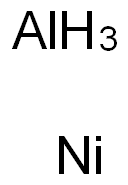Nickel aluminum is used in strengthening constituent in high-temperature nickel-base superalloys, coating blades in gas turbines and jet engines.
Flammability and Explosibility
Not classified
Nickel aluminide is a chemical compoundof the two metals, and when molded and sinteredinto shapes, has good oxidation resistanceand heat resistance at high temperatures. It is asintered nickel–aluminide material with a specificgravity of 5.9, and a transverse rupturestrength of 1034 MPa at 1093°C, twice that ofcobalt-bonded titanium carbide at the sametemperature. The melting point is 1649°C. Itresists oxidation at 1093°C. It is used for highlystressed parts in high-temperature equipment.This compound in wire form is used for welding,flame coating, and hard surfacing. An aluminumpowder coated with nickel may bemixed with zirconia or alumina, which willincrease the hardness and heat resistance of thenickel–aluminide coating. Columbium aluminideis used as a refractory coating as it ishighly resistant for long periods at 1427°C. Tinaluminide is oxidation resistant to 1093°C, buta liquid phase forms at about this point.
Nickel aluminide (NiAl) is available commercially in powder form in various mesh sizes from granular material to an average particle size of a few micrometers. Thermal shock resistance is quite good.
Nickel aluminide can be formed by hot pressing or by cold pressing and sintering, but the former method produces by far the best results. Excellent oxidation resistance and fairly good strength make this material of interest for turbine blading or other combustion chamber applications. It has impact resistance that is better than most ceramics, intermetallic compounds, and some cermets. NiAl is also resistant to attack by molten glass and red and white fuming nitric acid, which suggests possible uses in the glass-processing industry or in some high-temperature chemical processes.


